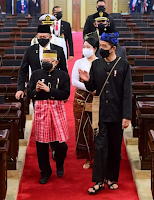Sunda Wiwitan
Unlike Outer Kanekes, the residents of Inner Kanekes still adhere to the traditions of their ancestors. The Kanekes Dalam people do not know written culture, so their customs, beliefs/religion & ancestral stories are only stored in oral speech. Based on information from the Kokolot of Cikeusik village, Kanekes people are not Hindus/Buddhists, but adherents of animism, a belief that respects ancestral spirits.
The beliefs of the Kanekes community are referred to as Sundanese Wiwitan teachings, ancestral teachings passed down from generation to generation which are rooted in respect for karuhun / ancestral spirits & worship of the spirits of natural forces. This belief is an original form of traditional Sundanese society which believes in the power of nature & ancestors. Not only that, magical things can be seen in Sundanese Wiwitan culture where they are still strong in the beliefs of their ancestors.
Their origins are often linked to Adam as the first ancestor. Van Tricht, a doctor who conducted health research in 1928, denied this theory. This can be seen from the behavior of the Sundanese Wiwitan people who have a duty/obligation to protect nature given by Hyang Kersa & maintain an intense relationship with their ancestors and do not live in luxury because they are carried away by worldly factors.
Hyang Kersa resides in Buana Nyungcung. One of the 7 Bataras handed down by Hyang Kersa is Batara Cikal, the oldest who is considered the ancestor of the Kanekes people. The Bedouin tribe will always carry out rituals together to maintain relationships with their ancestors, they also always work together to protect nature.
Badui people will plant rice once a year with local seeds in the fields. The planting-to-harvest period takes 5 months. All activities that will be carried out must be started by asking for the protection of the ancestors with the aim of good intentions and will run well too.
Their house of worship was called pamunjungan & at that time the largest and most luxurious pamunjungan was Pamunjungan Kihara Hyang which was located in Leuweung Songgom / Balay Pamunjungan Mandala Parakan Jati which is currently used as the Sindang Barang Cultural Village. Their holy book, called Kropak 630, is kept in Kuningan. Unfortunately, at this time we cannot see this pile of manuscripts because they are kept by Rama Anom & Mrs. Tati's youngest sister, Mrs. Dewi Kanti, the Public Relations Officer, who is not there.
This manuscript can still be read only by child number 2 who is Catholic & their father, Prince Djatikusumah. They are the descendants of Prince Madrais who, since the Dutch rule, never cooperated with the Dutch government, which caused him to go to prison in Boven Digoel. Apart from that, by looking at the concept of Sundanese Wiwitan Madrais teachings, the assumption that the ancient teachings of the ancestors, especially Sundanese Wiwitan teachings, means that the Indonesian people still adhere to animism, is rejected.
Although most aspects of this teaching are original traditions passed down from generation to generation, in subsequent developments these ancestral teachings were also slightly influenced by several aspects of Hindu, Buddhist & later Islamic teachings.




Comments
Post a Comment